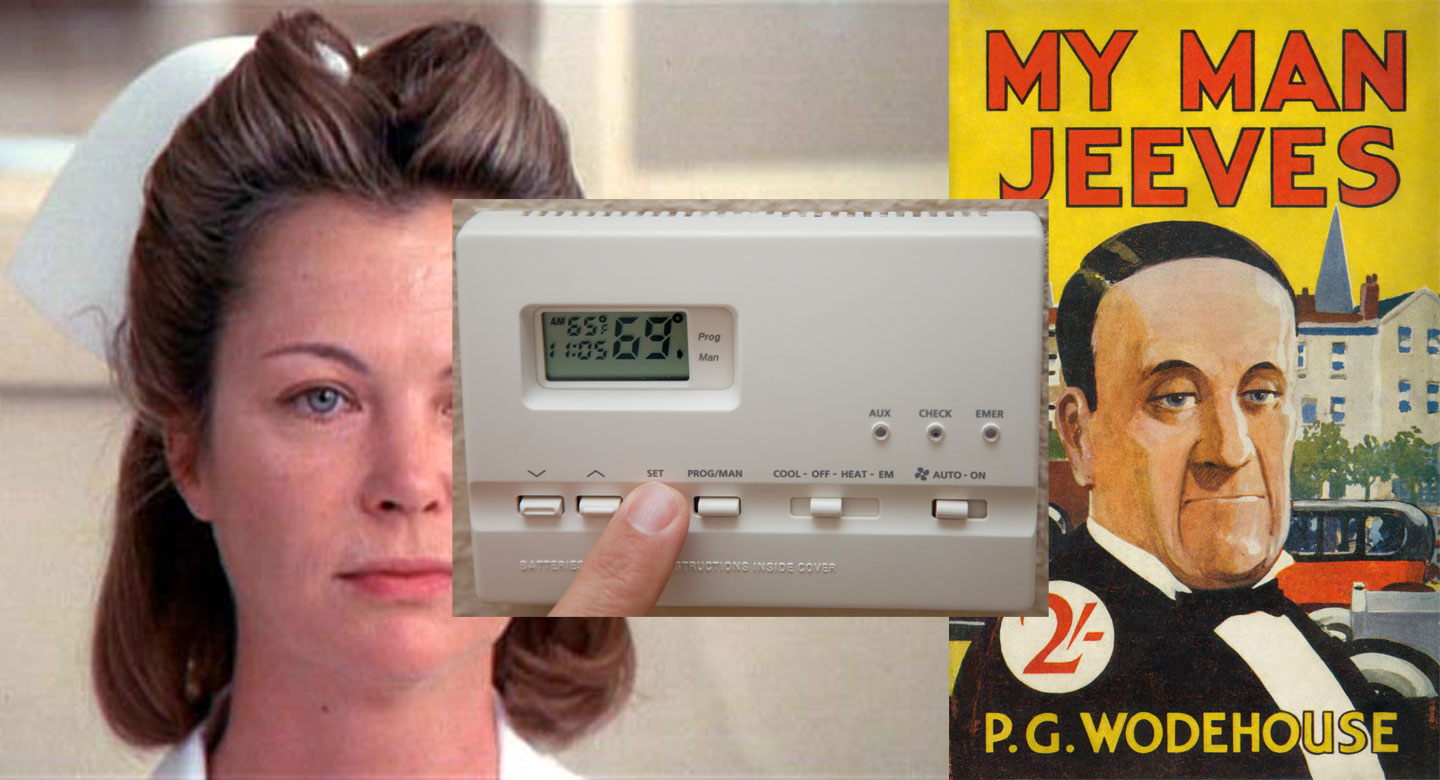By: Peter Zimmer | Posted: March 17, 2016 | Updated: April 5, 2023
If only Jeeves were in charge of product design for older adults!
Some thoughts about designing assistive technologies for the aging, including some who are cognitively impaired — especially thermostats.
Consider how technology developers and product designers seem to think about the household and personal devices they develop for the “aging” market. You have to wonder who are they designing for. It is certainly not for the caregivers and everyday users coping with Alzheimer’s Disease and the Electric Home.
I first started thinking about these design issues in the early 1990s, when my mother had Alzheimer’s Disease, and I was her caregiver.
I ask, as a user, as a caregiver and as a designer and design critic:
- Who do the product designers really serve?
- What is their driving motivation?
- And what is the effect on those who use what they’ve designed?
- And whose world view do we want guiding our designs?
Jeeves & Nurse Ratched
To put some humanity into this story, I’m going to recruit PD Wodehouse’s valet Jeeves, and Ken Kesey’s Nurse Ratched, to see how they’d do if we put them in charge of designing products for us.
Wodehouse’s comic novels featured Jeeves and Bertie Wooster. Bertie does not pay attention to the details of his life, the consequences of his actions, or the risks he runs.
He was young and foolish, and in many ways shared mental traits with my mother who was old and had Alzheimer’s Disease.
- “The premise of the Jeeves stories is that the brilliant valet is firmly in control of his rich and foppish young employer’s life. Jeeves becomes Bertie Wooster’s protector and all-purpose problem solver, devising subtle plans to rescue Bertie and his friends from tiresome social obligations, demanding relatives, brushes with the law, and, above all, problems involving women. Wodehouse derives much comic effect from having Bertie, his narrator, remain blissfully unaware of Jeeves’s machinations, until all is revealed at the end of the story.” (from Wikipedia, for an interesting overview.)
Nurse Ratched in Ken Kesey’s One Flew Over the Cuckoo’s Nest is also firmly in control, but she conceives her function to be control of locked up people who aren’t trusted to have any interests that really matter. She serves the powers that put people in her charge, and her own ego. She imposes requirements on the people in her care that no sane person would agree to voluntarily (again, see Wikipedia)
Jeeves and Bertie live and work in a pleasant home.
Nurse Ratched, McMurphy, Billy Bibbit, et al are confined together in a place that is as far from home-like as we can imagine.
Product Design according to Jeeves
Consider product designer Jeeves as an enabler for everyday users
- “Jeeves becomes … protector and all-purpose problem solver, devising subtle plans to rescue Bertie … [doing this in a way that Bertie] remain[s] blissfully unaware of Jeeves’s machinations, …”
To fill this role Jeeves must observe, understand and empathize with Bertie as he is, as he desires to be and as he acts. Jeeves also needs to have a realistic view of the world around Bertie, which Bertie doesn’t have. Bertie’s lack of awareness is wide-ranging and unconscious: he is not aware that he is not aware of consequences.
Product Design according to Nurse Ratched
Nurse Ratched ignores what her “patients” actually want, understand, or need, or what their previous lives were like. She imposes her order, requiring them to learn how to do things her way, or else. Her patients and underlings are always at risk of a slip or mistake, under penalty of ever greater punishments for failures to conform. Some are driven to despair, some to staging a rebellion…
In today’s new devices, I see most designs coming at the “caregiving” issues from a guardian/rescuer perspective, a point of view closer to Nurse Ratched’s than to Jeeves’.
The cared-for person and their attempts to go on living the life they used to live creates problems for the caregivers. And the new devices will, the designers seem to hope, be serving the caregivers (who are the paying customers after all), to make their lives easier, and to make the lives of those they care for “safer”.
The technology is used to watch and guard the cared for person 24/7, and warn caregivers (or their proxies) of any trouble they’re getting into, so caregivers can rescue them or prevent them doing more damage. Sometimes the technologies are simply locks of one sort or another.
But do these Nurse Ratched solutions really make the lives of the people we care for better, as they experience it, as they still want to live it? Are “fewer problems” and “safer” really making the experience of daily life “better”?
Thermostat Design and Alzheimer’s
Using those very things that had brought her comfort, pleasure, and contact with her family and community for decades, my mother’s frequent failures with her phone, stereo system, TV, thermostat increased problems for her and for me as her Alzheimer’s dementia progressed.
I found myself, two decades ago, feeling I had no options to “fixing” her problem appliances but locking them away, unplugging them, amputating the activities she really still valued.
Here’s what led me to lock away her thermostat:
She’d feel chilly, sitting watching TV. She’d get up and turn the thermostat’s dome to the right just a bit. Then sit down. A couple minutes later she’d still be chilly, and get up and turn it up another bit, never reading or understanding the numbers on its face. And she’d do it again three minutes later… “fiddling”, they call this behaviour. And when the room finally reached the 30º C (86ºF) maximum, after a quarter hour or so, she’d be overheated and then she’d start to turn it down, and sometimes get it down the bottom of the scale, at 5ºC (41ºF), close to freezing, where hypothermia was a real health risk.
The clear plastic box I put over the thermostat “solved” our problems of fiddling and fuel wasting and too hot and dangerously too cold temperatures. But Mom did not like being locked out and I did not like feeling like my only choice was being a Nurse Ratched.
Looking at thermostat choices available to caregivers today I find their thermostat problems are much the same, and their options are not much better almost two decades later.
Jeeves’ thermostat for my mother and those like her
So let’s put Jeeves to work on a thermostat redesign.
I want Jeeves to let my mom respond to what she feels – when she feels chilled, she still wants to turn up her own heat.
Jeeves’ role is protector, problem solver, he’ll need to be subtle (she’s easily confused).
- She’s unaware she is increasingly unable to judge exactly what needs to be done at the familiar Honeywell Dome, especially if she’s left her glasses by her chair.
He must not change the thermostat’s appearance too much from the one she’s used since the 1960s. She likely wouldn’t recognize a cream plastic box on the wall as a thermostat, its Up and Down buttons are meaningless, the LED display with its tiny unfamiliar icons just confuse her, if she notices them.
- She knows she is cold, she goes to her thermostat, turns it up with a habitual gesture. She may turn it as far as it will go all at once, or turn it up just a bit, but do it again and again. Either way, she can turn it all the way up before the room really warms at all. She can turn it down to near freezing. She may look at the numbers, but not make any sense of the dials, numbers or icons that she sees.
Nurse Ratched would say “that behaviour is unacceptable, she’s wasting heat, fiddling is Forbidden”, and screw a plastic lock box to the wall over the thermostat, locking her away from control of her warmth.
UI designer Jeeves says “Let’s consider the slips, mistakes, and errors she makes, and design a thermostat that prevents them, reduces their effect, while leaving her in control.”
Jeeves puts himself into a better thermostat, one with minor outward differences she likely won’t notice. Thermostat Jeeves now looks like her old dome. But he’s programmed for energy (and money) savings and turns his setting down overnight. He doesn’t care how far she turns his shell, 3 degrees or a full rotation is all the same to him: “right” is “make it warmer”, “left”, “it is too warm”. Jeeves filters out inattention, absentmindedness, fiddling behaviours. She can turn up her heat, but Jeeves allows only a 2ºC step at a time, and she can’t turn it up too far nor leave it up too long.
Like flipping a light switch, her habitual gestures now work, close attention not required. She really is back in control: she turns up her heat when she is chilly. Or turns it down if she’s ever too warm.
More Jeeves-type design needed
Of course product designer Jeeves’ thermostat job is not finished.
- We need him to create the interface that works for caregivers as they are, lets them program the thermostat even though they live on the other side of the continent, even though they may do this only once in a year, or even less often. They can’t possibly remember all the steps for a task done once and then repeated so rarely. They can’t find the manual, a small 36-page booklet printed in very small type, written by and for lawyers and engineers.
- We’d want the Jeeves-thermostat to shout for help if the heating system stops working in the middle of winter, or someone leaves a window or door wide open.
- And let’s have him design for the chance that Mom or Dad might live in one of the millions of homes or apartments that don’t have any Internet connection or WiFi or even a cable TV connection. We ask a Jeeves-thermostat to work in these really dumb older homes, ones with only connections to electricity and phone networks.
And could Jeeves please take a look at our 21st C. “smart” TV sets and their awful remote controls? And our microwaves? And our phones? We all make slips and mistakes when we use them. Can he design for all of us?
Just asking.
What do you think? To design things for you, for your loved ones, or for easy use by strangers or relatives who drop in to visit you, would you rather Jeeves or Ratched design for you?
– – – – – – – – – – –
Perhaps I’m dating myself a bit, referring to Jeeves and Nurse Ratched, two iconic characters from 20th century books and movies, but I’m writing this for the Boomer and pre-Boomer readers who have been users of personal and home appliances since the 1950s.
A Do-it-Yourself Alternative
Editor note: Here is a Do-it-Yourself approach to creating just the sort of Jeeves-type thermostat envisioned in this article.
*Disclosure: The research and opinions in this article are those of the author, and may or may not reflect the official views of Tech-enhanced Life.
If you use the links on this website when you buy products we write about, we may earn commissions from qualifying purchases as an Amazon Associate or other affiliate program participant. This does not affect the price you pay. We use the (modest) income to help fund our research.
In some cases, when we evaluate products and services, we ask the vendor to loan us the products we review (so we don’t need to buy them). Beyond the above, Tech-enhanced Life has no financial interest in any products or services discussed here, and this article is not sponsored by the vendor or any third party. See How we Fund our Work.




